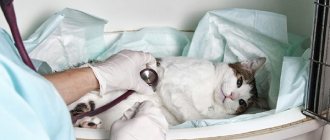6415Pavel
The tail is an important part of the animal's body. If a cat has a sore tail, this can be a serious problem for the whole body, since damage to the spine is possible.
Most often, injury causes tail pain. It is for this reason that cat owners usually turn to a specialist.
© shutterstock
How is it formed and manifested?
An abscess is a pus-filled formation under your pet's skin. This abscess occurs due to infection. Abscesses in cats must be treated. It is visually clear that the skin is raised and there is a formation under it. The essence of an abscess is that pus begins to form between the animal’s muscles and its skin. It can occur in any part of the animal’s body if it is of traumatic origin. On the face, an abscess forms in the area of the cheek or eye. This type of inflammation is associated with dental diseases.
Thus, abscesses are divided into 2 types. The first is considered traumatic, as it arose after receiving some kind of injury. And the second type is dental. This type of abscess is a consequence of dental inflammation.
How to distinguish a fracture from a tail bruise
A cat's tail fracture is accompanied by severe pain. Whenever you try to feel the tail, she will start screaming and struggling, but with an ordinary bruise this does not happen.
What does a cat’s tail “say”: let’s look at all the positions
In addition, with a fracture and damage to the integrity of the vertebrae, the deformation of a certain part is clearly visible, which is not observed with a bruise.
For your information! Bruises occur much less frequently than fractures, since the vertebrae in the animal’s tail are very delicate and are easily damaged when subjected to strong pressure.
Types
In addition, abscesses can be classified according to the type of progression of the disease.
- Cold. This disease refers to the chronic course of the disease. This abscess is characterized by the fact that it represents numerous deep relapses. A cold one can bother an animal for several years.
- Superficial abscess in cats. This type of abscess is located directly under the skin. It breaks through on its own and never causes complications.
- Deep abscess. Often the cause of its formation is a bite. Because of this, a seemingly small but deep wound is formed. This tissue rupture is filled with pus, which penetrates into the depths. Visually, the inflammation is not noticeable, but a compaction can be felt. This abscess is more severe than a superficial one. It also requires more careful treatment.
- Acute abscess in a cat. Treatment is required immediately. Since this type differs in that it progresses quickly, as a rule, it opens itself.
- Benign abscess in a cat. The inflammatory process occurs with white or yellowish discharge. They are not purulent in nature and do not have an unpleasant odor. As a rule, this abscess goes away quickly.
- Malignant abscess. This type of disease indicates that the animal has a weakened immune system. The inflammatory process spreads to neighboring tissues. If the disease affects the cat's mouth, then an unpleasant odor is released from the oral cavity.
Treatment
It all depends on the characteristics of the injury and the condition of the pet. If, after a severe “root” fracture of the tail, the cat cannot control urination and defecation, everything is not too good (as we already wrote about above). However, most often, injuries to the tail, including its fractures, are treated quite simply (although full mobility of the organ is not always restored).
In case of open fractures of the tail , surgical treatment of the wound is performed, small fragments of bones, fur and other contaminants are removed from the canal. This is first aid. It is recommended to apply plates and staples to the vertebrae, which reduce the mobility of the tail and accelerate the process of healing of cracks and chips. If the tail is literally broken to such an extent that the affected part is supported by the remains of blood vessels and skin, its complete amputation .
For closed tail fractures, splints or pressure bandages are applied to the organ, immobilizing the organ and also accelerating the healing process.
As with any other type of fracture, the cat must be limited in its movements as much as possible during the recovery period. To do this, you can use special portable cages or ordinary baskets. This will allow the bone tissue to recover faster and prevent possible damage to the nerve cords. When amputating the tail, there is no need for such strict measures. In addition, it is necessary to inspect the splints and bandages daily: they should not contain blood, exudate, or other signs of the inflammatory process.
Daily treatment of the post-operative wound with antiseptic solutions may be required (in consultation with your veterinarian). Within about 10-14 days, complete fusion of the bone tissue of the tail occurs (under ideal conditions). Once again we warn owners of sick animals that the original mobility of the organ, as a rule, is no longer restored. A tubercle, a bend, and other traces of injury remain on the tail.
Perianal abscess in cats
Paraanal glands are present in mammals. They are interconnected with the rectum. Located near the anus. Their task is to scare away other animals by emitting an unpleasant odor. An abscess of the paraanal glands in cats, as a rule, after maturation, uncorks itself and comes out. But a fistula forms.
This process has a hard impact on the animal. But later the pet’s condition stabilizes.
Possible complications of abscesses
If an abscess in a cat is not treated in a timely manner, the inflammation spreads to adjacent tissues and organs. From the ear the process can move to the brain area. With a paraanal abscess, infection can penetrate into the gastrointestinal tract and reproductive system.
With all forms and types of abscess there is a risk of blood poisoning. At the same time, the animal’s behavior worsens, it becomes more aggressive, and can damage interior items. In advanced cases, there is a risk of developing immunodeficiency, which provokes any complications even with harmless and non-contagious diseases.
Why might illness occur?
When interacting with other animals, small wounds or bites may occur. Injury can also occur due to negligence. Open wounds provide direct access to infections. An interesting fact is that the smaller the wound, the greater the likelihood of an abscess. This is explained by the fact that when the wound is open, foreign microelements leave the body through blood and pus. But when it is small and deep, for example from the bite of another animal, then the small area of damage on top quickly heals, and inflammation begins inside. You should be aware that your pet's claws or teeth may contain germs. When they enter the body, they can lead to inflammation.
Prevention of tail diseases
If injuries or tumors are difficult to prevent, then owners can protect their pet from problems due to excess oil on the skin. You should constantly care for the animal's fur, not only when bald areas appear . An excellent remedy is fish oil; it should be added to the food.
After a cat is injured, it is important to monitor its health - take it to a doctor for examination, and get an x-ray of the affected organs. Immediately after injury, you can carefully palpate the cat’s tail and pay attention to painful areas. If there is an open wound, you need to act immediately. You can apply ice to the sore tail ; it will relieve the pain a little and allow you to get to the veterinary clinic .
A balanced diet allows you to avoid a lack of calcium in the diet, but this deficiency is the cause of the development of bone caries.
Causes of an abscess in a cat
Let's look at the reasons why this disease may occur.
- The animal’s body begins to fight foreign microelements that have entered the body through the immune system, but due to the lack of possibility of their release, an inflammatory process begins.
- The process of suppuration begins due to dental disease. As a rule, teeth are damaged by some hard object. Destruction can also begin in older animals.
- An abscess may occur due to the use of unsterile instruments during treatment. Interfering with an animal's body using unsterile devices can lead to infection. Even a puncture for an injection can become a source of infection.
What symptoms does the animal have?
It is difficult to externally determine the presence of an abscess in an animal, since the wound is small and goes away quickly, and internal inflammation is not visible. Therefore, you can suspect that an inflammatory process is going on in your pet’s body based on its lethargic state. If the abscess is in the mouth, and the cause of its occurrence is the teeth, then you may notice that the cat eats on one side or spits out food. May begin to rub the sore spot on the floor.
Cats are unique in that they can tolerate pain. Therefore, if at least some deviation from normal behavior is noticed, then it is necessary to take a closer look at the animal. You should be aware that an abscess, especially if it occurs in the oral cavity, can cause blood poisoning. Also, education can cause immunodeficiency in cats, even after the body has recovered.
If the disease progresses, a tumor will become noticeable.
Diagnosis of tail fractures
Urinary incontinence in a cat: what to do at home
A cat's tail fracture must be diagnosed by a doctor. Even if the damage is obvious, the specialist must find out which part of the tail is damaged and assess how serious the pet’s general condition is. And based on the results of the examination, an individual decision is made on the methods and methods of treatment.
Most often, the veterinarian will need to take an x-ray to make a correct diagnosis. This will allow you to more accurately determine the location and extent of the injury.
If the animal's symptoms are more severe, then if there is a problem with the motor ability of the hind legs or with stool, blood and urine tests, as well as an ultrasound, will have to be done. This will make it possible to assess the risks and prognoses for the health and life of the animal. In addition, this can exclude the presence of damage to other nearby organs, for example, a fracture of the sacrum.
With a complicated fracture, the cat will not be able to sit or move around.
Development
The abscess develops gradually. It all happens like this:
- An infection occurs at the site of damage to the skin.
- A slight swelling occurs. It may be accompanied by redness.
- The temperature at the tumor site rises. Therefore, you feel that this place is warm to the touch.
- The animal has painful sensations. Therefore, the pet tries to evade probing.
- As the disease progresses, the swelling increases and becomes red.
- The inflammatory process that occurs inside becomes visible through the skin.
- You should know that if the abscess does not open on its own or veterinary care is not provided, then the purulent lesion will spread to other tissues of the body.
Is it possible to treat on your own?
Many pet owners who have encountered the problem described remember their confusion in the first minutes when they discovered that the cat’s tail was broken and were at a loss what to do. You need to realize that if we are talking about a fracture, then you cannot do without the help of a specialist. It is the veterinarian who will make the correct diagnosis and prescribe the necessary treatment.
At home, you can try to treat a dislocation yourself (if you are confident in the diagnosis) or a fracture not complicated by displacement. In this case, a tight bandage of a special fixing bandage is applied to the damaged area, which will protect it from unnecessary movements. The bandage is applied for 3 weeks.
But in this case, you need to be prepared for some problematic issues that arise during treatment: it is rarely possible to apply a bandage tightly enough, a sick cat can scream and struggle, and remove the fixing bandage on its own (in this case, experts recommend putting a special collar on the animal).
Recommendations
If an abscess is found in a cat, how to treat it at home? It is recommended to show the animal to a veterinarian to make an accurate diagnosis and prescribe a course of therapy. A disease such as an abscess is common in cats. Since it needs to be opened, it is better to do this at a veterinary clinic.
This procedure can be done in two ways: under local anesthesia or general anesthesia. The veterinarian will determine how this operation will proceed after an examination. And depending on the condition of the animal, he will prescribe which painkiller is best for making the incision.
Although abscess is a common condition in cats, hairless cats are less susceptible to it. The reason for this state of affairs is that cats without fur are kept by their owners in favorable conditions. Therefore, they do not have the opportunity to sort things out with other animals and enter areas other than their own.
As a rule, to eliminate the inflammatory process, cats are prescribed antimicrobial agents. These include sulfonamide drugs. It is necessary to give your pet a course of medications. You should not stop taking medications, even if your cat’s abscess appears to have become smaller. Antibiotics should be taken as a course. It is 5 or 7 days. The bottom line is that when the course of drugs is interrupted, the body can develop immunity to their components. And if you need to take these medications again, they will not have the desired effect on the body.
Joint disease
Joint disease can also cause discomfort in your cat. The tail consists of small joints, so it can also be susceptible to disease.
Most often, this disease is hereditary. Sometimes the problem occurs when there is a lack of calcium in the body. There may be a lack of other microelements.
If the disease is hereditary, the cat will complain not only of pain in the tail, but also in the paws. If there are problems with the joints, the tail will become unplastic.
© shutterstock
The problem can be diagnosed using x-rays. Then the veterinarian will be able to prescribe therapy.
Abscess in cats. Treatment at home
There are different situations in life. And no one can exclude the possibility that the cat owner will not have the opportunity to come to the veterinary clinic and place his pet in the hands of professionals. If such a situation occurs, then it is necessary to carry out treatment yourself. You should be prepared to lance the abscess. The main thing is not to worry and consistently carry out all the steps to treat the animal.
- First of all, you should determine at what stage the disease is. If it is possible to identify an abscess at the initial stage, then warm compresses should be applied. Warming up the localization of the purulent process will accelerate its maturation. If the pet's condition is lethargic, it means that he is worried about pain. To relieve pain, you can inject Novocain.
- If the abscess is at a more serious stage and is severely inflamed, then heating cannot be done. What to do? When the abscess is at a more advanced stage, an incision must be made. This procedure should be done without fail, since the pus may begin to spread to other tissues if it is not released.
- To make an incision, you need to take a sterile needle, razor or scalpel. If the abscess is small, then a needle will do. For large ones you need to use a razor or scalpel. The procedure should be carried out with gloves. You will also need gauze pads, hydrogen peroxide, manganese and antibiotics.
- You should think about how to keep your cat stationary. To do this, you need to ask for help or figure out in advance how to hold the animal while making the cut.
- Before proceeding to the incision, you need to perform local anesthesia using the drug Novocaine or Lidocaine. The abscess site should be punctured. Next, you need to give time for the painkiller to take effect, about 10 minutes.
- Next, you should make an incision, allow the fluid to drain from the wound and treat it with antibiotics.
- Then you need to monitor the wound so that it does not heal prematurely and treat it with antibiotics. The bandage should be loose.
If the incision is small, the abscess should go away in a couple of weeks.
Causes of pain
Among the most common reasons are the following factors:
- Fractures, injuries, bruises. An unsuccessful fall, fights with other individuals, or getting into an accident lead to various injuries to the spinal column. If an animal is injured in such situations, immediate attention to the clinic is required. An x-ray will help determine the location of the fracture. Prompt assistance will help restore the cat's activity in a short time. Even a small wound received during a fight with cats can lead to severe pain. The animal will suffer from discomfort, pain, the inability to perform maneuvers during jumping, inconvenience during sleep (cats need to take the safest position for rest, tucking their tail, and if it hurts, then the pet cannot settle down for sleep for a long time);
- Tumor. If the cat does not allow you to touch the base of its tail, then this place is very painful. The cause may be a developing tumor. Associated signs include passivity and lethargy in behavior; when stroking the back, the animal emits a plaintive meow or, conversely, a strong hiss. With similar sounds, the cat makes it clear that a sore spot is nearby;
- Congenital pathologies of the development of the spinal column. There are often cases when an individual is born with defects in the back and spine. From the moment of birth or upon reaching a certain age, cats lower their tail, tuck it towards their stomach, and cannot lift it to perform a maneuver or when showing emotions. Situations are very common among inexperienced breeders. The owners cross incompatible breeds, which leads to mutation of the spine, muscle tissue, and even rupture of ligaments. If the ligamentous apparatus is damaged, the cat experiences severe pain. At the veterinary institution, the animal is given a special bandage for at least one year to regain the ability to move;
- Joint diseases. Tail pain may be due to deformity or degeneration of the joints. In most cases it is a hereditary factor. Such diseases are accompanied by pain in the paws, drooping and immobilization of the tail.











